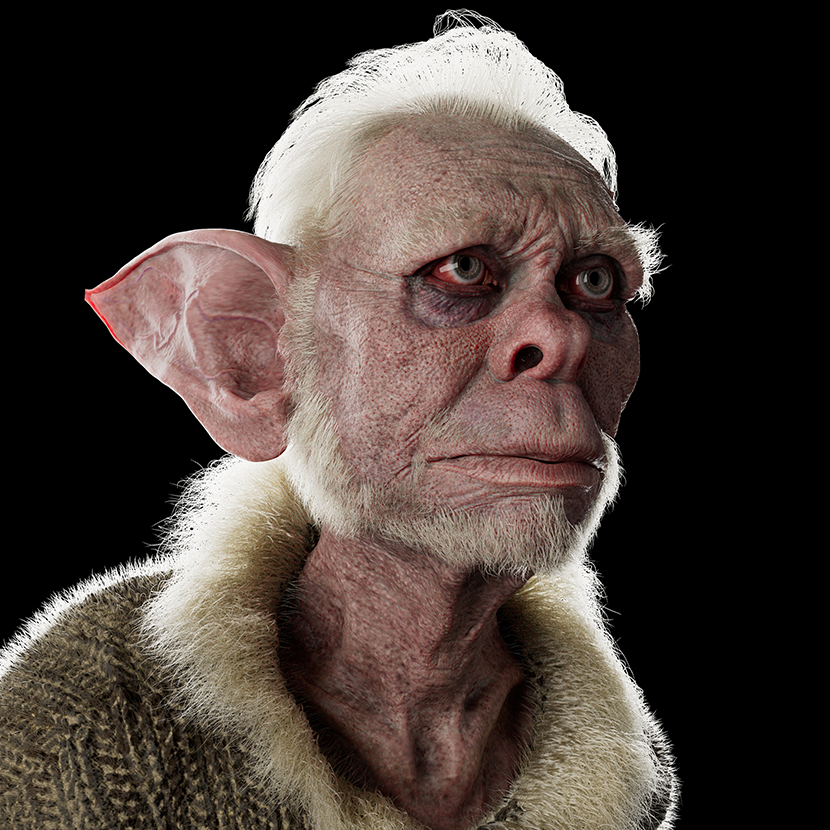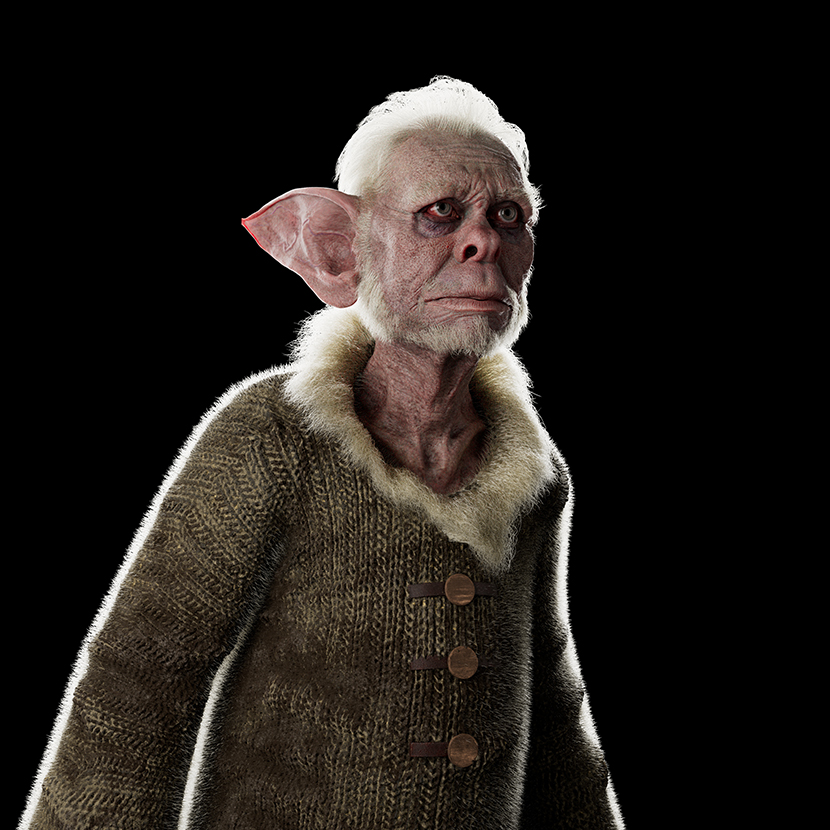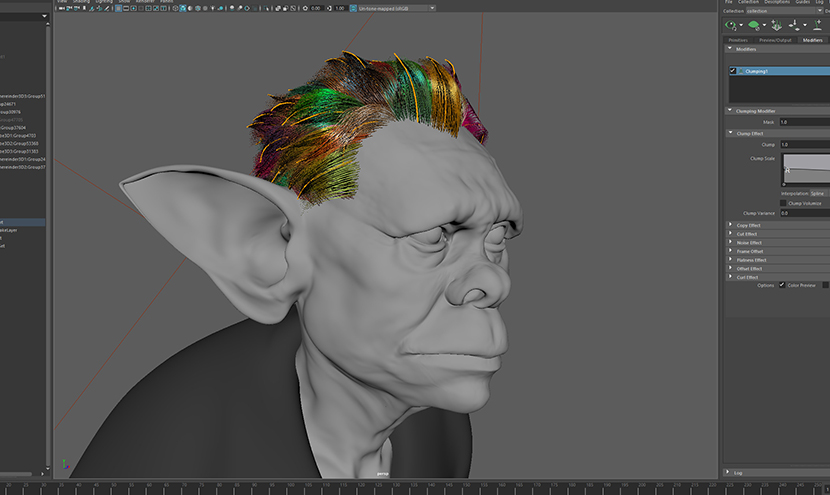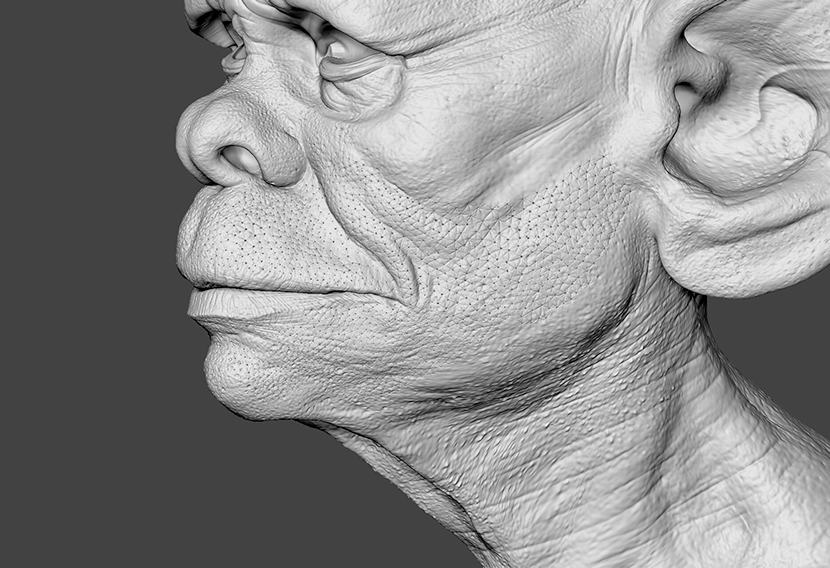
Throughout human history, myths and folklore have served as an important outlet for our desire for creative expression. While often fantastical in nature, the themes and morals contained within these age-old stories still apply to and reflect our experiences. It is no wonder then, that their universal appeal continues to inspire creative minds to this day, and Fabricio Rezende, our Rebus Render Farm September 2022 3D Artist of the Month, is no exception! His depiction of a leprechaun sees the traditionally mischievous creature far removed from its pot of gold, a hauntingly hopeless victim of abject poverty.
In our interview, Fabricio recalls his professional journey from the agricultural to the video game industry, reveals the real-life origins of his leprechaun, and speaks on the importance of finding your own artistic voice.
 A piercing yet glazed look in his eyes, Fabricio Rezende's ‘Leprechaun’ is a haunting modern-day interpretation of an Irish legend.
A piercing yet glazed look in his eyes, Fabricio Rezende's ‘Leprechaun’ is a haunting modern-day interpretation of an Irish legend.
Hi Fabricio, thanks for joining us! To start things off, please introduce yourself to our readers.
Hello, I am Fabricio Rezende, I am a 44-year-old 3D generalist and character artist from Brazil, currently residing in Canada. I have a background in illustration and comic books and work as a senior artist at Relic.
Let’s start at the beginning: when and why did you decide to pursue a professional career in the CG industry?
Long before I ever thought about CGI, I was working in landscaping, planting garlic and such. I actually have a degree in agriculture and only started dabbling in 3D at the age of 28, when I was first introduced to 3ds Max. You might consider me somewhat of a late bloomer in that regard. Although to be fair, I have always had an artistic inclination and was even teaching classes on traditional portraits on the side.
That is a rather surprising turn of events! How did you then fully transition from landscaping to 3D artist?
It was a gradual shift. I began by creating architectural environments for landscaping projects, but I soon realized 3D work was a lot more lucrative than my actual job. At the same time, I had caught the bug and was really enjoying the work. So, I decided to pursue it further, although finding the right training took me several attempts. I first enrolled in digital design, then in architecture, but I dropped out both times after only one semester. Finally, I discovered the 'Think Tank Training Center' in Vancouver, Canada, and that turned out to be the perfect fit.
Returning to the present, please tell us about your current job at Relic Entertainment.
Sure! Relic is an award-winning gaming studio mostly focused on strategy games. As senior artist, I am doing everything from modeling, sculpting, texturing, grooming, to lookdev, rendering and compositing, and game engine integration. Together with the rest of the team, I am responsible for creating cinematic assets and characters as well as in-game portraits. Right now, I am working on 'Company of Heroes 3', the latest entry in a long-running franchise of real-time strategy games set during WWII.
You have extensive experience in the video game industry. Before joining the team at Relic, you worked for several high-profile studios, including Electronic Arts and Goldtooth. Can you briefly summarize your professional history up to this point?
Yeah, at EA I worked as character artist on the UFC and FIFA series, sculpting the bodies and heads for the athletes in the games. At Goldtooth, I worked as a generalist, doing modeling, sculpting, texture renders and comp for various projects, including cinematics for some of the Marvel IPs. Before that, I worked for visual effects and production companies such as 'Zoic' and 'Filmgate', as well as various advertising studios back in Brazil.
Was it always your plan to work in the gaming industry? What games do you enjoy yourself, if any at all?
I always wanted to work in a field adjacent to art, and video games were a natural progression after I started using digital tools. Personally, I like real-time strategy games and first-person shooters, like Doom.
Gaming companies have repeatedly come under fire for frequently subjecting their employees to crunch time and hostile work environments. What has your experience been like in this regard?
While I have experienced similar conditions when I was still working in advertising back in Brazil, I fortunately have not been subjected to anything like that since relocating to Canada and entering the gaming industry. For this and other reasons, I consider myself very privileged!
 This half-body shot shows more of the creature’s worn-out clothes.
This half-body shot shows more of the creature’s worn-out clothes.
Describe your profile as a 3D artist! What are your main areas of expertise?
I am a generalist specialized in characters, likeness models, digi-doubles and creatures.
From 3D generalist to character and texture artist, you have worked a number of different positions. How did you end up specializing in characters?
As I have already mentioned, I started out doing archviz animations for landscaping projects. Later, as I worked in advertising, I needed to expand my skill set to visualize basically any kind of idea. Over the years, I became more and more specialized in characters,
Are there any design principles or specific school of thoughts you adhere to? What inspires you as a 3D artist?
Speaking more broadly as an artist, 3D is just a tool, inspiration comes from many different places. That is why my biggest influence is not a CG artist but realist painter 'Mauricio Takiguthi', who was my master in Brazil. Also, though I think this goes without saying, my time at Think Tank Training Center was extremely formative for my development as a 3D artist.Let’s talk about your work in more detail, namely ‘The Leprechaun’ character you submitted to our campaign. Can you first of all describe the circumstances that lead to the creation of this project?
‘The Leprechaun’ was my attempt to develop a mythical creature while heavily humanizing its features. This allowed me to combine my aesthetic affinity for mysterious creatures with a narrative of social awareness, as the Leprechaun’s sad and tired appearance mirrors the homeless I have seen all throughout my life.
What were your main goals in doing this project? Was it more of a technical exercise or about the creative expression?
I think these can hardly be separated, creative expression and technique go hand in hand, after all, especially when it involves realism. Artists have always been technical and technological innovators, think for example of Vermeer and how he tried to capture light using the devices of his time.
That said, having total control and creative freedom with my own art is a very powerful and satisfying feeling, and it definitely was a driving force for this project.
What parts of the image were especially important to you, both from a visual/design and technical point of view?
The eyes and the blend between the geometries (head, eyes, beard etc.).
What were some of the challenges you had to overcome?
Working a full-time job, the biggest challenge was to make time for a personal project in the first place; it took me about a month of working in my spare time to complete it. More specifically, figuring out how to have a 1:1 displacement from ZBrush to Maya with Arnold proved quite tricky.
 While the end result is not quite as colorful, Fabricio did a great job on the hair.
While the end result is not quite as colorful, Fabricio did a great job on the hair.
Let’s dive a bit deeper into the character itself! Why did you choose to create a leprechaun? Was there a particular piece of media or artwork that inspired you?
I am a big fan of reinterpreting 2D concepts in 3D, and this project originally started as a tribute piece to one of Rob Bliss’s creature designs – he has always been one of my favorites. However, in search of my own artistic expression, I soon deviated from this approach, and the project took on a life of its own. Another artist whose style has inspired me a lot is Carlos Huante.
While leprechauns are usually characterized as malicious or mischievous tricksters, your depiction is of a wise, maybe even vulnerable creature. What made you go for this look and how did you achieve it?
Sometimes, a scary face is the best disguise for vulnerability. For me, all creatures, all living beings, have two sides, light and dark. Maybe even nightmares can dream…
The creature’s clothes too are functional instead of flashy, with subdued colors instead of the bright green most often associated with leprechauns. Tell us a bit about your choice of clothes, their material, color and your texture work.
The idea behind the homeless appearance of my leprechaun is to show that even legendary beings fall victim to the societal ills that plague humanity all over the world, such as poverty. It is a subtle critique on a value system that places profit above all, and what a lack of social equity and solidarity does to us and our people.
What an ingenious juxtaposition! How did the idea of a homeless leprechaun come to be?
This was inspired by a pretty sad real-life encounter: there was this homeless man in my neighborhood, an Irishman with a big red beard. He lived in a park and would always go to the nearby Starbucks, where he performed a puppet show to earn some money. His puppets had beards as well, and he always reminded me of a sprite or pixie. Whenever I saw him, I stopped for a chat, invited him for a coffee or bought him some fruit. He was a perfect gentleman, very funny and always happy, and we had many great conversations.
Then after a while, he vanished. The last time I saw him was on the bus, he was drenched to the bone and coughing hard, he was obviously very sick. There was this look of resigned hopelessness in his eyes, it was so sad. I wish I could do more to help…maybe I can use my art to raise awareness for the ever-increasing social and economic gaps we are faced with.
 Thanks to the intricate work Fabricio did on the leprechaun’s skin, every crease and wrinkle tells a story.
Thanks to the intricate work Fabricio did on the leprechaun’s skin, every crease and wrinkle tells a story.
Can you walk us through your development and production process step by step?
Sure! I always start with a quick sketch, sometimes I render it by hand to understand the lighting. I then immediately created my head base mesh (in this case I used Metahuma), because my goal is to always give life to the character as soon as possible. Next, I moved to sculpting, all of which was done in HD mode in ZBrush. Then I exported the first subdivision of all the meshes to Maya and exported the displacement to affect the mesh in Maya, complete with physical camera and accurate physical lighting. All maps were developed in ZBrush and painted by hand by the way.
The skin, pores, and wrinkles are organized according to the priorities between the primary, secondary, tertiary, and quaternary forms, interconnecting the muscles and the fat over the surface. To achieve the best results for the cavities, I used the subsurface scattering effects of the Arnold shader on the Leprechaun’s head. Finally, I played around with cloth simulation for some additional realism.
What software did you use to create this piece? Any plug-ins you found particularly helpful?
I used Unreal 5, ZBrush, Arnold and Substance Painter for the clothing. The most notable plug-ins I used were XGen and the Unreal Live Link to transfer data between Unreal and Maya.
What has the feedback been like so far? Are you satisfied with the results yourself?
The feedback has been great! Which honestly surprised me, as I have suffered a lot more working on other pieces without receiving similar appreciation LOL.
What is one thing you yourself have learned from this project that you can share with us?
Following your own artistic vision is so much more satisfying than copying others!
 Using art to raise awareness: another profile shot of the crestfallen creature.
Using art to raise awareness: another profile shot of the crestfallen creature.
Have you used RebusFarm before? If so, please tell us about your overall experience. Is there anything you especially like about our service?
I have in the past, when I was still in advertising, though I did not have the chance to use it since. Maybe once I finish the animation I am currently working on, I can use my RenderPoints to render it with RebusFarm!
In closing, is there anything else you want to say? Any plugs, shoutouts or present or upcoming projects you’d like to mention?
The animation I just mentioned is part of a larger personal project called ‘The Wanderer’, which I am very excited about. I will first tell the story as a graphic novel, made with a comic shade in Zbrush and Krita. Please check out and follow this Instagram account for previews!
Fabricio, thank you so much for taking the time and all the best in the future!

Get started with your own renderings
